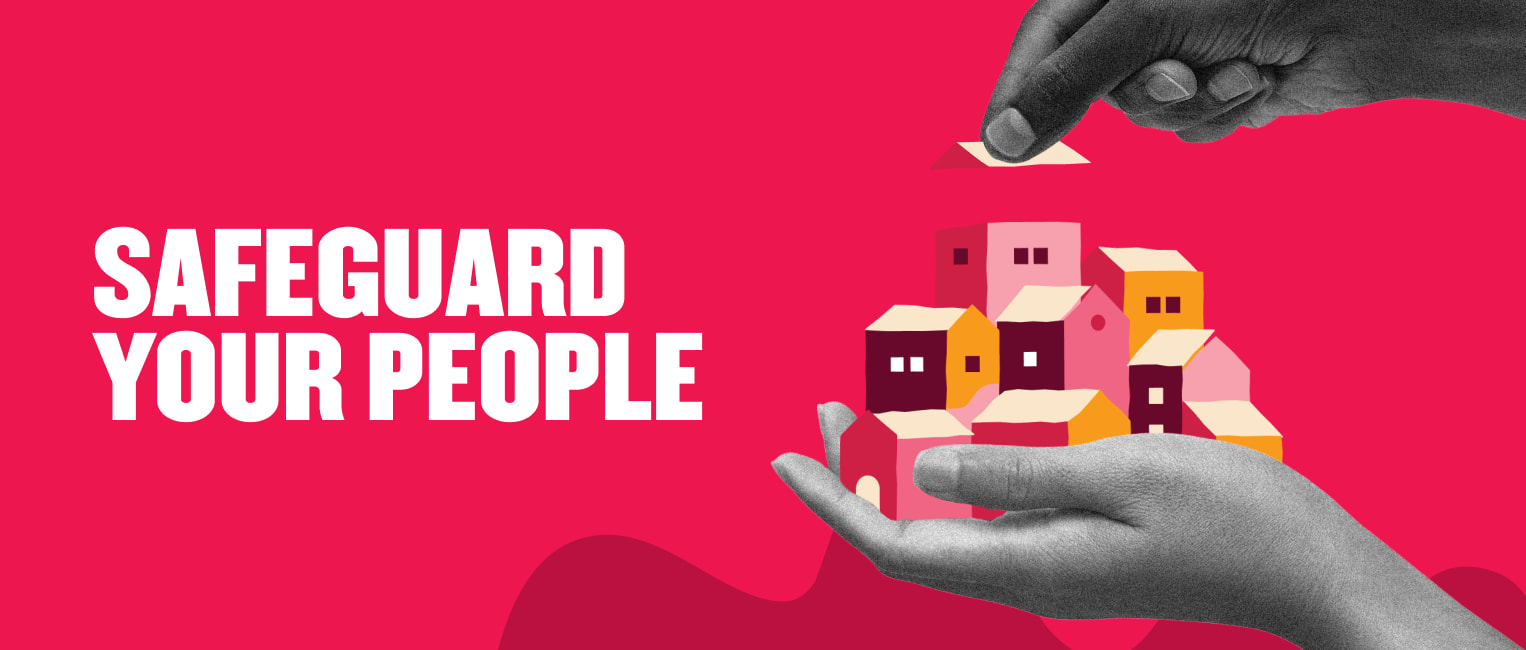When natural disasters strike, they bring unparalleled challenges, not just to communities but also to workplaces with employees directly affected by these events. Natural disasters disrupt lives, routines, and businesses. People may face challenges ranging from physical displacement to emotional distress.
From immediate actions to long-term strategies, HR can provide stability and reassurance in turbulent times. This guide offers practical steps for helping your people navigate the aftermath of natural disasters and prepare for future crises.
Start by providing essential physical and financial support
Natural disasters often leave people scrambling to meet basic needs, including shelter and food. Prompt action from HR can make a significant difference. Addressing immediate physical and financial needs creates a sense of stability and shows people that the organization’s top priority is their wellbeing.
- Reach out to directly affected team members. Communication is the cornerstone of an effective crisis strategy. A brief phone call can reassure your people that the organization is there for them and offer insights into their current situation. Use the conversation to confirm their and their families’ physical safety, determine whether they’ve been displaced, and understand their immediate needs. Additionally, assess what essential items they’ve lost, including personal belongings and company equipment, and find out where they’re staying if they’ve been displaced. This information enables HR to deliver relevant, personalized aid quickly.
- Distribute essential resources promptly. Provide care packages with necessary supplies, organize meal trains, or set up temporary assistance funds. For remote or international teams, coordinate delivery services to ensure people receive the essentials they need.
- Facilitate disaster pay and compensation options. Where applicable, make a point to inform team members of disaster pay provisions and insurance benefits. Partner with payroll teams to expedite payments and provide financial relief quickly.
- Connect your people to community resources. Share information about local shelters, aid organizations, or government assistance programs to help your people access broader support networks.
Establishing a physical safety net is also fundamental to building psychological safety in your workplace and, more broadly, in your people’s personal lives in times of crisis.
Offer psychological safety and emotional support
The emotional toll of natural disasters can affect people’s overall wellbeing and their ability to perform and engage at work. Research by the National Institute of Mental Health underscores the severity of that toll: Nearly one-third of disaster survivors may develop PTSD, anxiety, or depression.
While people’s physical safety may be beyond the organization’s control, creating an environment that champions understanding and care is critical to helping your people feel valued, understood, and supported.
Here’s how:
- Provide mental health support. Offer free or subsidized counseling sessions, whether through Employee Assistance Programs (EAPs), one-on-one sessions, or group therapy. Create safe spaces that encourage open communication about mental health challenges where people can talk freely about their experiences, express their feelings, and seek resilience strategies.
- Equip your people with empathy and communication training: Empathy and understanding go a long way in helping employees recover emotionally. Equip managers and team members with the tools to communicate effectively and empathetically with colleagues in distress. Offer training sessions to help the team understand the broader impact of natural disasters and how to engage sensitively with affected peers.
- Encourage open conversations: Encourage managers and unaffected team members to engage in honest and empathetic dialogues with impacted employees. Small gestures, like regular check-ins or team support groups, can make a big difference. Thoughtful questions like, “What would be most helpful to you right now?” or “How can we support you?” allow people to share their needs openly.
- Offer flexible leave policies. Providing paid or unpaid leave options allows people affected by natural disasters to focus on managing personal and family needs without added pressure. By offering this support, HR reinforces the organization’s commitment to prioritizing employee wellbeing during challenging times.
By prioritizing psychological safety, HR shows the organization’s tangible commitment to supporting its people as they navigate the aftermath of crises.
Double down on organizational resilience with flexibility
Whether it’s natural disasters, geopolitical conflict with employees in active war zones, or the everyday challenges of unpredictable markets, pandemic lockdowns, and generational shifts, the survival of modern businesses depends on organizational resilience.
In the face of natural disasters, the ability to rapidly implement company-wide flexibility tactics is crucial to maintaining stability and supporting employees during uncertain times. Proactively adapting work arrangements also demonstrates that the organization values its people over productivity during crises.
- Offer flexible or additional leave. Flexible leave policies are vital for both employee wellbeing and organizational resilience. These policies can alleviate the stress of balancing work with recovery efforts, whether individuals need time to secure housing, care for loved ones, or recover emotionally. Furthermore, offering flexibility during crises builds loyalty among employees and helps safeguard the organization from potential turnover, reducing the need to invest in recruitment and training for replacements.
- Enable remote work options. For those who can work remotely, provide tools and resources to help them stay connected and productive. Ensure team members have access to the equipment and platforms they need.
- Reassess and redistribute workloads. Natural disasters can leave some team members unable to work at full capacity due to physical or emotional strain. To maintain business continuity and reduce pressure on impacted individuals, reallocate tasks across teams. Circumstances can change abruptly, so explain to employees that sudden schedule adjustments may be necessary. Leverage the strength of your broader team by encouraging colleagues in unaffected areas to step up and provide additional support. This approach ensures stability while fostering a sense of collaboration and care within the organization.
By embedding flexibility into your organization’s DNA, you build a resilient foundation that allows you to respond effectively to immediate crises. But flexibility is just one piece of the puzzle. True resilience requires a proactive approach—one that ensures your organization is ready to face future challenges with confidence and care.
Build a strategy for the future
While providing immediate support is crucial, the best crisis management strategies provide robust plans that prepare organizations for future crises:
- Establish a crisis management framework. Develop clear protocols for responding to natural disasters, including communication plans, resource distribution, employee safety tracking systems, and guidelines for providing physical and psychological support. Monitor and refine your policies regularly to ensure they remain relevant and effective.
- Train for crisis preparedness. Incorporate regular training sessions to keep your people and managers prepared for unexpected events. Include guidelines for communication, employee support, workload reallocation, and resource distribution. Know your people’s rights during natural disasters according to jurisdiction, for example, disaster pay through insurance as a benefit.
- Track workforce capacity. Implement systems to monitor employee availability and workload capacity during crises. Track who can work full-time, part-time, or not at all, and use this data to make informed decisions about workload adjustments.
- Create a culture of transparency and empathy. Regularly communicate with the organization about preparedness efforts and foster a culture that prioritizes understanding and flexibility. For example, share regular updates about disaster preparedness plans through company-wide emails or meetings. Host training sessions to equip everyone, from individual contributors and managers to C-level decision-makers with the skills they need to handle crises effectively.
Planning ahead is the best way to prepare your organization to handle, deter, and reduce the lasting impact of natural disasters on the workplace. By building systems, training teams, and committing to transparency, HR leaders can create a more resilient organization. These efforts go far in ensuring your workplace is ready to adapt to future challenges while protecting your people and business continuity.
Recommended For Further Reading
TIP: Best practices for absence management
Tracking capacity and understanding workforce needs during natural disasters is essential. Equip managers with tools to:
- Monitor people’s availability and capacity realistically
- Strategically delegate tasks across teams to maintain productivity without overburdening any group (e.g., leverage international teams)
- Communicate clearly and compassionately about workload expectations
By taking these steps, HR leaders can create an environment where people feel genuinely supported during and after a natural disaster. Preparing for the unexpected ensures that businesses can continue to thrive while putting their people’s wellbeing first.
Support your people with resilience, strategy, and care
Natural disasters test the resilience of organizations and their people. HR’s role in these moments extends beyond operational continuity—it’s about ensuring your people feel safe, supported, and valued. By focusing on immediate support and long-term preparedness, organizations can turn challenging moments into opportunities to demonstrate care and build lasting trust with their teams.
By championing trust and strengthening organizational culture, HR leaders can help businesses navigate uncertainty with empathy and purpose. Combining swift, thoughtful action with strategic, long-term planning enables organizations to endure crises and emerge stronger. Robust people-first strategies that align with business goals create a foundation for resilience, ensuring the workplace can adapt, recover, and thrive in the face of future challenges.


